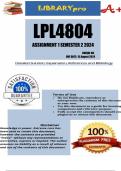Samenvatting
ECB3ADAVE2 - Applied Data Analysis and Visualization II - Full Summary
A detailed summary of all the relevant unsupervised learning methods. Based on the book, articles, lecture slides, exercises & assignments and articles and videos I found through Google. Edit: I got told that the hyperlinks in the document don't work. Once you have bought the summary, please...
[Meer zien]













